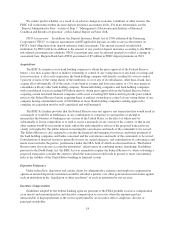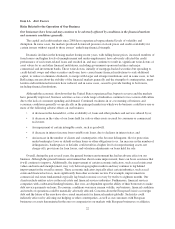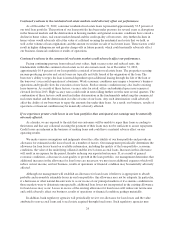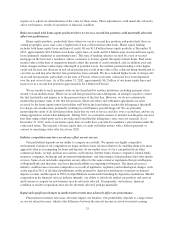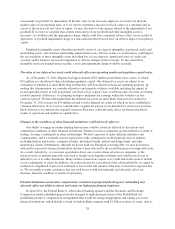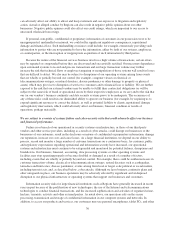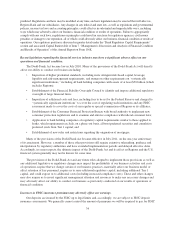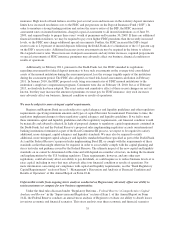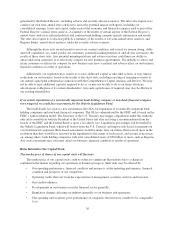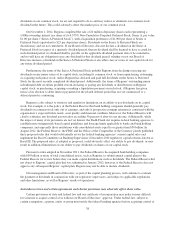Regions Bank 2012 Annual Report Download - page 44
Download and view the complete annual report
Please find page 44 of the 2012 Regions Bank annual report below. You can navigate through the pages in the report by either clicking on the pages listed below, or by using the keyword search tool below to find specific information within the annual report.assessments of goodwill for impairment. If the fair value of our net assets improves at a faster rate than the
market value of our reporting units, or if we were to experience increases in book values of a reporting unit in
excess of the increase in fair value of equity, we may also have to take charges related to the impairment of our
goodwill. If we were to conclude that a future write-down of our goodwill and other intangible assets is
necessary, we would record the appropriate charge, which could have a material adverse effect on our results of
operations. A goodwill impairment charge is a non-cash item that does not have an adverse impact on regulatory
capital.
Identifiable intangible assets other than goodwill consist of core deposit intangibles, purchased credit card
relationship assets, and customer relationship employment assets. Adverse events or circumstances could impact
the recoverability of these intangible assets including loss of core deposits, significant losses of credit card
accounts and/or balances, increased competition or adverse changes in the economy. To the extent these
intangible assets are deemed unrecoverable, a non-cash impairment charge would be recorded.
The value of our deferred tax assets could adversely affect our operating results and regulatory capital ratios.
As of December 31, 2012, Regions had approximately $763 million in net deferred tax assets, of which
$35 million was disallowed when calculating regulatory capital. Our deferred tax assets are subject to an
evaluation of whether it is more likely than not that they will be realized for financial statement purposes. In
making this determination, we consider all positive and negative evidence available including the impact of
recent operating results as well as potential carryback of tax to prior years’ taxable income, reversals of existing
taxable temporary differences, tax planning strategies and projected earnings within the statutory tax loss
carryover period. We have determined that the deferred tax assets are more likely than not to be realized at
December 31, 2012 (except for $70 million related to state deferred tax assets for which we have established a
valuation allowance). If we were to conclude that a significant portion of our deferred tax assets were not more
likely than not to be realized, the required valuation allowance could adversely affect our financial position,
results of operations and regulatory capital ratios.
Changes in the soundness of other financial institutions could adversely affect us.
Our ability to engage in routine funding transactions could be adversely affected by the actions and
commercial soundness of other financial institutions. Financial services companies are interrelated as a result of
trading, clearing, counterparty or other relationships. We have exposure to many different industries and
counterparties, and we routinely execute transactions with counterparties in the financial services industry,
including brokers and dealers, commercial banks, investment banks, mutual and hedge funds, and other
institutional clients. Furthermore, although we do not hold any European sovereign debt, we may do business
with and be exposed to financial institutions that have been affected by the recent European sovereign debt crisis.
As a result, defaults by, or even mere speculation about, one or more financial services companies, or the
financial services industry generally, may lead to market-wide liquidity problems and could lead to losses or
defaults by us or by other institutions. Many of these transactions expose us to credit risk in the event of default
of our counterparty or client. In addition, our credit risk may be exacerbated if the collateral held by us cannot be
realized or is liquidated at prices not sufficient to recover the full amount of the loan or derivative exposure due
us. We are unable to make assurances that any such losses would not materially and adversely affect our
business, financial condition or results of operations.
Potential limitations on incentive compensation contained in proposed federal agency rulemaking may
adversely affect our ability to attract and retain our highest performing employees.
In April 2011, the Federal Reserve, other federal banking agencies and the Securities and Exchange
Commission jointly published proposed rules designed to implement provisions of the Dodd-Frank Act
prohibiting incentive compensation arrangements that would encourage inappropriate risk taking at covered
financial institutions, which includes a bank or bank holding company with $1 billion or more of assets, such as
28


